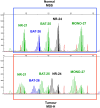Microsatellite instability in gastric cancer: molecular bases, clinical perspectives, and new treatment approaches
- PMID: 30173350
- PMCID: PMC6182336
- DOI: 10.1007/s00018-018-2906-9
Microsatellite instability in gastric cancer: molecular bases, clinical perspectives, and new treatment approaches
Abstract
Gastric cancer is one of the most aggressive malignancies, with limited treatment options in both locally advanced and metastatic setting, resulting in poor prognosis. Based on genomic characterization, stomach tumour has recently been described as a heterogeneous disease composed by different subtypes, each of them with peculiar molecular aspects and specific clinical behaviour. With an incidence of 22% among all western gastric tumour cases, stomach cancer with microsatellite instability was identified as one of these subgroups. Retrospective studies and limited prospective trials reported differences between gastric cancers with microsatellite stability and those with instability, mainly concerning clinical and pathological features, but also in regard to immunological microenvironment, correlation with prognostic value, and responses to treatment. In particular, gastric cancer with microsatellite instability constitutes a small but relevant subgroup associated with older age, female sex, distal stomach location, and lower number of lymph-node metastases. Emerging data attribute to microsatellite instability status a favourable prognostic meaning, whereas the poor outcomes reported after perioperative chemotherapy administration suggest a detrimental role of cytotoxic drugs in this gastric cancer subgroup. The strong immunogenicity and the widespread expression of immune-checkpoint ligands make microsatellite instability subtype more vulnerable to immunotherapeutic approach, e.g., with anti-PD-L1 and anti-CTLA4 antibodies. Since gastric cancer with microsatellite instability shows specific features and clinical behaviour not overlapping with microsatellite stable disease, microsatellite instability test might be suitable for inclusion in a diagnostic setting for all tumour stages to guarantee the most targeted and effective treatment to every patient.
Keywords: Adjuvant chemotherapy; Gastric cancer; Immune-checkpoint inhibitors; Microsatellite instability; Molecular stratification; Predictive and prognostic value.
Conflict of interest statement
The authors declare that the research was conducted in the absence of any commercial or financial relationships that could be construed as a potential conflict of interest.
Figures


References
-
- Bang YJ, Van Cutsem E, Feyereislova A, et al. Trastuzumab in combination with chemotherapy versus chemotherapy alone for treatment of HER2-positive advanced gastric or gastro-oesophageal junction cancer (ToGA): a phase 3, open-label, randomised controlled trial. Lancet. 2010;376:687–697. doi: 10.1016/S0140-6736(10)61121-X. - DOI - PubMed
-
- Fuchs CS, Tomasek J, Yong CJ, et al. Ramucirumab monotherapy for previously treated advanced gastric or gastro-oesophageal junction adenocarcinoma (REGARD): an international, randomised, multicentre, placebo-controlled, phase 3 trial. Lancet. 2014;383:31–39. doi: 10.1016/S0140-6736(13)61719-5. - DOI - PubMed
-
- Wilke H, Muro K, Van Cutsem E, et al. Ramucirumab plus paclitaxel versus placebo plus paclitaxel in patients with previously treated advanced gastric or gastro-oesophageal junction adenocarcinoma (RAINBOW): a double-blind, randomised phase 3 trial. Lancet Oncol. 2014;15:1224–1235. doi: 10.1016/S1470-2045(14)70420-6. - DOI - PubMed
Publication types
MeSH terms
Substances
Grants and funding
LinkOut - more resources
Full Text Sources
Other Literature Sources
Medical
Research Materials

